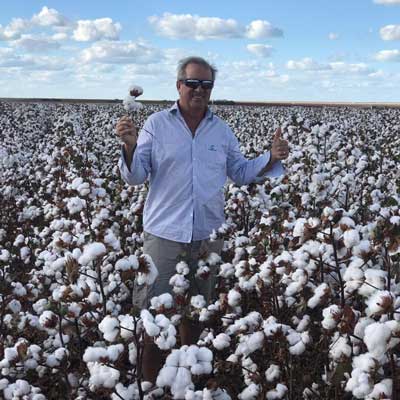
As a 12 year old, Celito Breda already picked soybeans with his own hands in the region of Jacutinga, countryside of Rio Grande do Sul. He took a liking for soy and continued to grow food, spending more than a decade working with agriculture in southern Brazil. In 1988, he migrated to Western Bahia, where he became one of the pioneers of what would become a hub of agricultural producers. He started with irrigated beans, but soon after began planting soybeans.
“Working on agricultural frontiers was very challenging. There were uncertain climatic factors, very fragile soils, new and unknown pests,” Celito recalls.
The region where his farm is set up is known as Matopiba (At the juncture of the states of Maranhão, Tocantins, Piauí, and Bahia), and comprises 337 municipalities that add up to about 37 million hectares of the Cerrado Biome, the second largest in South America. It is a very dry ecosystem, fertile ground for extreme meteorological phenomena, such as the “veranicos”, periods of drought with intense heat and sunstroke that can compromise entire soybean crops.
The “veranicos” frightened Luiz Pradella in his first season in western Bahia. During the 2001/2002 harvest, the lack of rainfall resulted in a loss of almost 100 percent of production. In the following harvest, it was the pests that devoured the crop.
Much like Celito, the Pradella family also switched from growing soybean in South Brazil, in Paraná, to the new frontier of the Cerrado. They were attracted to a region that until then was barely explored and lacked infrastructure, but which offered large amounts of land for more advantageous prices.
Both producers would soon find out it would be necessary to work with nature.
Historically, the conversion of native vegetation into productive agricultural areas has been the means for farmers to ensure short-term profit. However, it is the increase in crop productivity harvest after harvest that makes Matopiba a good place for soybeans.
“We started experimenting with sustainable practices because we need stable, balanced and harmonious environments,” Celito says. Together with Luiz Pradella and other producers, he has begun to adopt No-Tillage Systems (NTS), to improve the infiltration of water into the soil and increase the capacity of plants to absorb more nutrients, ultimately increasing yields.
Pradella celebrates the results. “With better soil, we produce more: we jumped from 3 tons of soybean per hectare to up to 5 tons per hectare,” he says. In addition to the gain in productivity, he reports that in 13 years of NTS, there was an increase of 0.8 percentage points of carbon in the soil. This equates to an equivalent average accumulation of 215 trees with 10 years of life, or the burning of more than 25,000 liters of diesel fuel.
Systems like no-tillage are just one example of how producers in Bahia are looking for sustainable ways to increase production of soy, without converting native vegetation.

Celito Breda, Bahia
Juliana Monti, coordinator of the soybean program at Solidaridad Brazil, describes this as a mindset shift for an entire generation of producers: “When they arrived, more than 20 years ago, converting native vegetation guaranteed gains and made good business sense; now, they need to serve a market that requires soybeans produced with sustainable practices and deforestation-free areas”.
According to research by Solidaridad, there is hunger for agricultural expansion in Matopiba. About 60 percent of landowners in western Bahia plan to expand soybean production. And while, to date, 54 percent of producers still see conversion as the most financially sustainable option to expand their production, an ever-larger proportion of them sees opportunities to increase productivity and expand into available cleared areas as a suitable alternative. Incentives and investment will play a key role here. In fact, 67 percent of producers surveyed as part of a Solidaridad study funded by the SCF in Western Bahia shared that the key to expanding in cleared areas are financial incentives and subsidies.
“We have the challenge of finding the point of intersection between producer and industry demands,” says Juliana. “Payment strategies to preserve Cerrado native vegetation need to be built together with producers. Any solution will need not only to be effective, but also present clear benefits for producers.”
Producers like Celito and Luiz seem to echo this sentiment, and many of them look at carbon markets as clear opportunities to receive payments for the large amount of carbon hijacked by their land. “Our region could grow horizontally up to 70 percent and vertically about 500 percent in the next 20 to 40 years. For this, we need a lot of support inside and outside the gates,” urges Celito. “I’m a born optimist,” shares Luiz. “Within the gate we’re doing our part: learning and improving productivity, using less impactful and more sustainable techniques”.

